Banksy’s Street Art Paints the Town
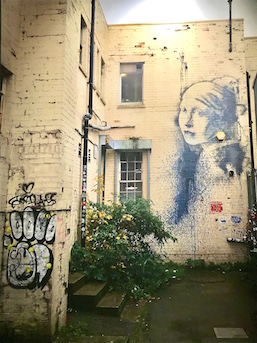
Who is Banksy?, now showing at Warehouse Terrada in Tennozu Isle until December 5th, has come to Tokyo less than a year after a different Banksy exhibition debuted in Yokohama. After Tokyo, the show will continue on to Nagoya, Osaka, Koriyama and Takaoka. Its works are largely from the globe-touring exhibition “The Art of Banksy.” What makes Banksy resonate among multiple generations is perhaps his dark humor and occasional use of subversive symbols. As designer Paul Smith remarked, Banksy speaks of the “corrupted truth” in human society that many of us are too nervous to articulate. His exhibitions are flocked to in the thousands, and his works are auctioned at shocking prices. They evidently echo people’s doubts about our current political, social, and cultural states.
The Girl with a Pierced Eardrum (2014, Bristol, UK) appears on a replica of a wall in the Albion Dockyard of Bristol, England, where the original art can be found. A different take on Vermeer’s “Girl with a Pearl Earring,” Banksy’s version has replaced the girl’s earring with an outdoor security alarm. In 2020, the same mural was given a face mask to reflect the global pandemic, but whether the addition was, indeed, executed by Banksy himself or another person has not been verified.
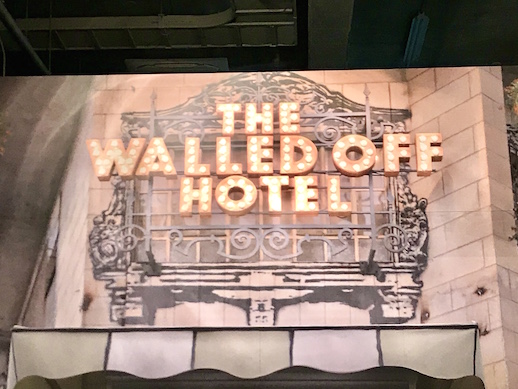
The current exhibition is particularly engaging thanks to its movie set-like installations, which escort the visitor through streets, alleys, and tunnels in the U.K. and U.S. decorated with Banksy’s art. Visitors can also walk through a recreated street scene from Gaza, Palestine showing the abysmal conditions around the separation barrier. Alongside this display is a stage set of the “Walled Off Hotel” in Bethlehem, Palestine, with interiors marked by Banksy. The presentation style offers a realistic experience of the artworks on a life-sized scale.
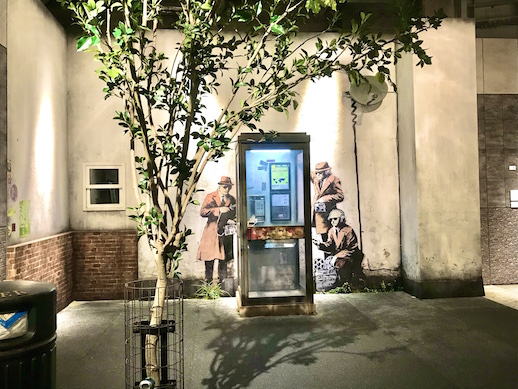
Another intriguing mural is Spy Booth (2014, Cheltenham, UK), which displays three 1950s-era spies listening in on a conversation at a phone booth—widely presumed to be Banksy’s critique on government surveillance. Two of the three spies were believed to be representations of whistleblower Edward Snowden and WikiLinks founder Julian Assange. The wall art appeared originally on the side of a building in Cheltenham, England, not far away from the British intelligence and security organization Government Communications Headquarters. The work created a stir when it mysteriously disappeared in 2016 after the state legislature decided to reconstruct the entire building to protect it from aging. This year, the heads of the spies were found and have been put on auction by entertainment label Cosmic Wire.
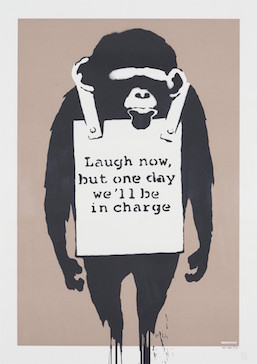
Banksy’s rat subjects were believed to be his homage to the so-called father of stencil graffiti, Blek le Rat. In Gangsta Rat (2004), the rat wears a chain medallion necklace and a NY Yankees baseball cap. It sits next to a boombox. The character portrayal of underground New York lifestyle that was prevalent across the UK in the 1980s and 1990s is utterly unmistakable.
For those who have followed the corporate legacy of the late Apple co-founder Steve Jobs, The Son of a Migrant from Syria (2015, Calais, France) is a powerful message of irony surrounding the Syrian migrant crisis and accumulation of wealth. Banksy painted the mural in a migrant camp in Calais, France. He used the character of Steve Jobs, whose father was a Syrian migrant to the U.S., as a farcical statement to negate public opinion that migration is a drain on a country’s resources. Jobs is seen carrying a sack of his belongings and his first Apple Mac computer, which made him wealthy while his company has paid over $7 billion a year in taxes.
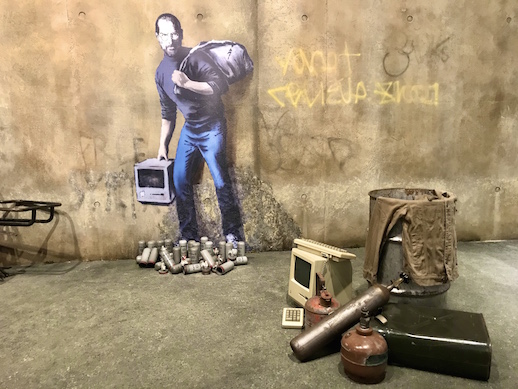
Finally, no one can dismiss Girl with a Balloon (2002, London, UK), considered to be Banksy’s most identifiable “trademark.” The figure of innocence in the little girl who releases a red, heart-shaped balloon in the air was first drawn on the staircase of Waterloo Bridge in London in 2002. Banksy had used this picture several times in social campaigns, such as those for saving Syrian children in 2014. In the exhibition, the words “There is always hope” are written on the wall next to the picture. The celebrated artwork ignited a global buzz during a Sotheby’s auction in 2018, when it was sold for a million pounds, but was shredded by a mechanical device Banksy had hidden inside the frame. Consequently, the piece was given a new name, “Love in the Bin,” and was auctioned once more in October 2021 for £16 million.
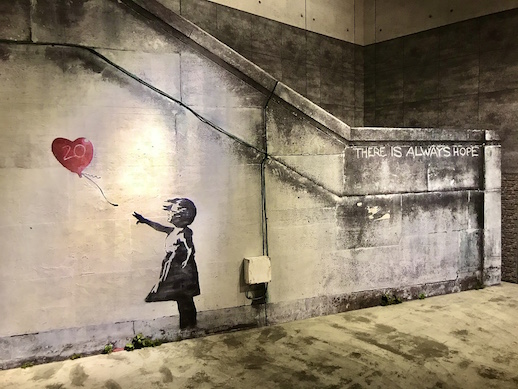
Despite the enormous wealth and fame that Banksy has been bestowed within the last 30 years, he remains unmaterialistic, often appearing as an ordinary street artist in sneakers and a hooded sweatshirt. His creations speak to us about certain delusions in societal norms, shortcomings of political and social systems, and the perpetual human struggle to understand life’s existence.
Alma Reyes
Alma Reyes



